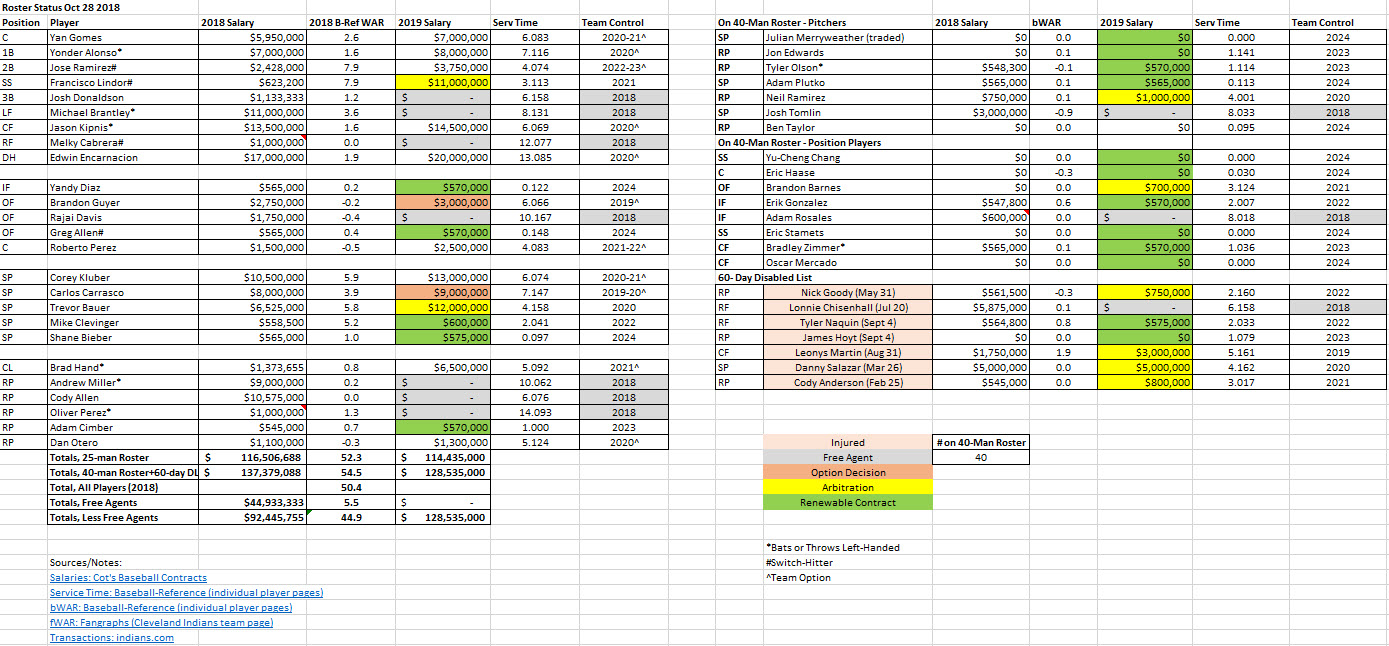The offseason begins today, and with it an avalanche of free agent speculation, trade rumors, and general strategic talk. I think the Indians will be much more active this winter than they have the last two offseasons, my basis for this being their 2018 performance (in both the regular and postseason) as well as the payroll itself.
I hope these two charts will clearly illustrate why I think this will be a wild hot stove season.
(Disclaimer: Past performance doesn’t correlate perfectly with future performance, both on an individual or a team level, this is just to illustrate the constraints the Indians find themselves in at this point in time.)
First, let’s look at the team’s performance in 2018.
(live version can be found here)
The above is one of my typical Excel charts listing the Indians’ 25-man/40-man rosters. There are a couple new things added that may be useful in providing some context that has been missing from these rosters: a comparison of total team Wins Above Replacement to the team’s competition in the American League. After all, what good is a statistic unless you have something to measure it against? I averaged the two flavors of WAR for each AL team, and ranked them at the bottom-right of the chart.
The Indians finished fourth in the AL by this measure, showing that if anything they should have had a better record (thanks, bullpen). The number used in comparison with the rest of the league is the total output of all players on the 2018 team, even those who had long-since been released by the team (the Oliver Drakes, the Alexi Ogandos, etc.)
I bring up these 2018 team numbers in order to focus the scope of offseason prognostication somewhat. I submit that if the Indians accumulate 50.6 WAR in 2019, they’ll make the playoffs again. Heck, they may make the playoffs if they hit 45.0 WAR if the rest of the AL Central continues to languish, but I don’t want to assume that, and neither should the Cleveland front office. Heck, if the competition in the AL Central gets better, it will be harder for the Indians to replicate that performance. So for the sake of this exercise, assume that the Indians will need to at least get to 50 wins above replacement.
This second chart concentrates more on the financial end of the equation.
The Indians ended 2018 with a roughly $137,400,000 payroll. The chart isn’t capturing the exact number, because the salaries of released players aren’t included, and many of the players on the list only made a partial salary (as they spent portions of the season making a minor-league salary), but it’s close enough for my purposes. Of that $137.4M salary, about $45M is going away via free agency, but a large portion of that savings is going to be eaten up by organic (arbitration and contract salary increases) growth.
To approximate the 2019 payroll if the Indians stand completely pat (letting all free agents walk, keeping everyone else), I’ve added back salaries for internal replacements for the free agents; for example, Tyler Olson/Neil Ramirez/Cody Anderson/Danny Salazar replacing the three free agent relievers plus Josh Tomlin. I calculate that the Indians, if they keep everyone on the roster that isn’t a free agent, will have an Opening Day payroll of $128,500,000, leaving the team about $9-10M to spend on bringing in new players if the salary budget remains the same in 2019.
Given that the free agents were worth 5.5 bWAR (and that includes the -0.9 bWAR that Josh Tomlin “contributed”), they aren’t going to be able to pay market value by signing free agents to make up for that lost production and be able to maintain their 2018 payroll (the market rate was between $8-9M/WAR last year). They should be able to replace some of that production with lower salary players (Yandy Diaz, for example, could help on that front as an everyday player), but there aren’t a lot of young players on the cusp of stepping into full-time roles. Maybe Tyler Naquin finally has a breakout season in right field, maybe Cody Anderson becomes the next Bryan Shaw, and maybe Danny Salazar becomes an elite closer, but I wouldn’t bet on all of these things happening.
So the Indians will need to both cut payroll and add talent. Cutting payroll could be as simple as non-tendering players like Danny Salazar, who is probably going to make $5M in arbitration, trading players like Jason Kipnis or Yonder Alonso in partial salary dumps, or even dealing core players like Trevor Bauer or Corey Kluber for total salary relief and young/talented players. Note that I’m not endorsing trading Bauer or Kluber unless the absolutely perfect deal comes around, but with the Indians’ circumstances, it’s a possibility. The Indians could also strip mine their farm system (where the talent is heavily concentrated in the lower rungs of the system) in order to patch the holes, putting all their eggs in the 2019-2020 baskets, all but ensuring the years after that will see a total rebuild.
One other thing to keep in mind is that several of the big market teams, after a couple years of restraint, are going to be extremely aggressive in free agency. The Yankees in particular are poised to spend wildly after having gotten under the luxury tax threshold in 2018 (thus avoiding a 50% surtax). That will affect not only the big names in free agency, but will have a trickle down effect on the lower tier free agents. That will make things more difficult for a team like the Indians to spend in free agency, but it might also make players like Kipnis and Alonso more attractive to teams that don’t want to spend the big bucks on a free agent.
So buckle in, Tribe fans…it’s going to be an interesting hot stove.


